parking sensors TOYOTA CAMRY HYBRID 2022 Owners Manual
[x] Cancel search | Manufacturer: TOYOTA, Model Year: 2022, Model line: CAMRY HYBRID, Model: TOYOTA CAMRY HYBRID 2022Pages: 624, PDF Size: 13.76 MB
Page 317 of 624
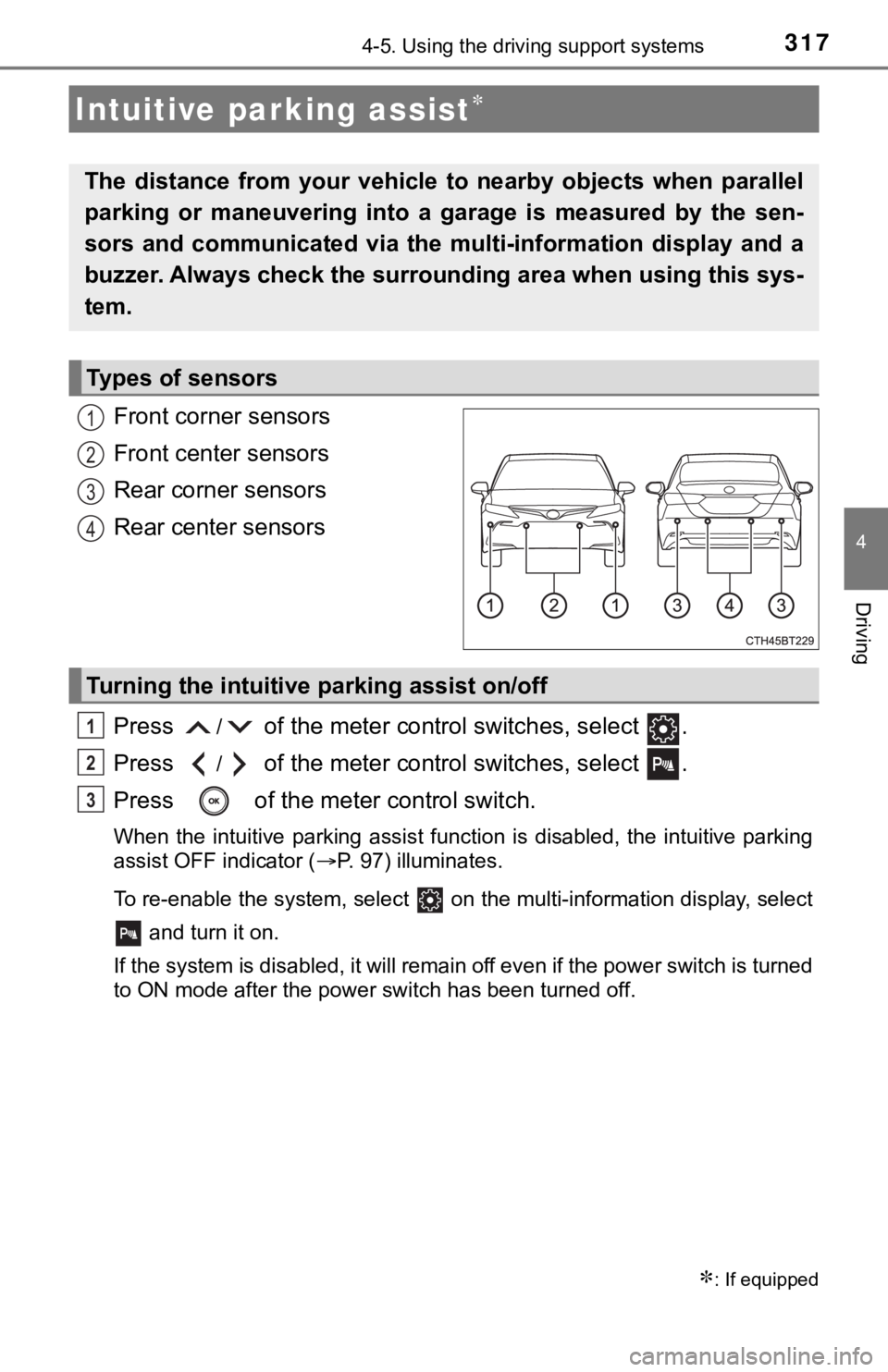
3174-5. Using the driving support systems
4
Driving
Front corner sensors
Front center sensors
Rear corner sensors
Rear center sensors
Press
/ of the meter control switches, select .
Press
/ of the meter control switches, select .
Press of the meter control switch.
When the intuitive parking assist function is disabled, the intuitive parking
assist OFF indicator (P. 97) illuminates.
To re-enable the system, select on the multi-information display, select
and turn it on.
If the system is disabled, it will remain off even if the power switch is turned
to ON mode after the power switch has been turned off.
Intuitive parking assist
: If equipped
The distance from your vehicle to nearby objects when parallel
parking or maneuvering into a garage is measured by the sen-
sors and communicated via the multi-information display and a
buzzer. Always check the surrounding area when using this sys-
tem.
Types of sensors
1
2
3
4
Turning the intuitive parking assist on/off
1
2
3
Page 318 of 624

3184-5. Using the driving support systems
When the sensors detect an object, the following displays inform the
driver of the position and distance to the object.
Front corner sensor operation
Front center sensor operation
Rear corner sensor operation
Rear center sensor operation
Select to mute the buzzer
sounds.
■Muting the buzzer sound
●To mute the buzzer sound
The buzzer can be temporarily muted by pressing of the meter con-
trol switches while an object detection display is shown on the multi-infor-
mation display.
●To cancel the mute
Mute will be automatically cancelled in the following situations.
• When the shift position is changed
• When the vehicle speed exceeds a certain speed.
• When the intuitive parking assist is turned off once and turned on again
• When the power switch is turned off once and turned to ON mode again
• When a sensor is malfunctioning
Display
1
2
3
4
5
Page 323 of 624
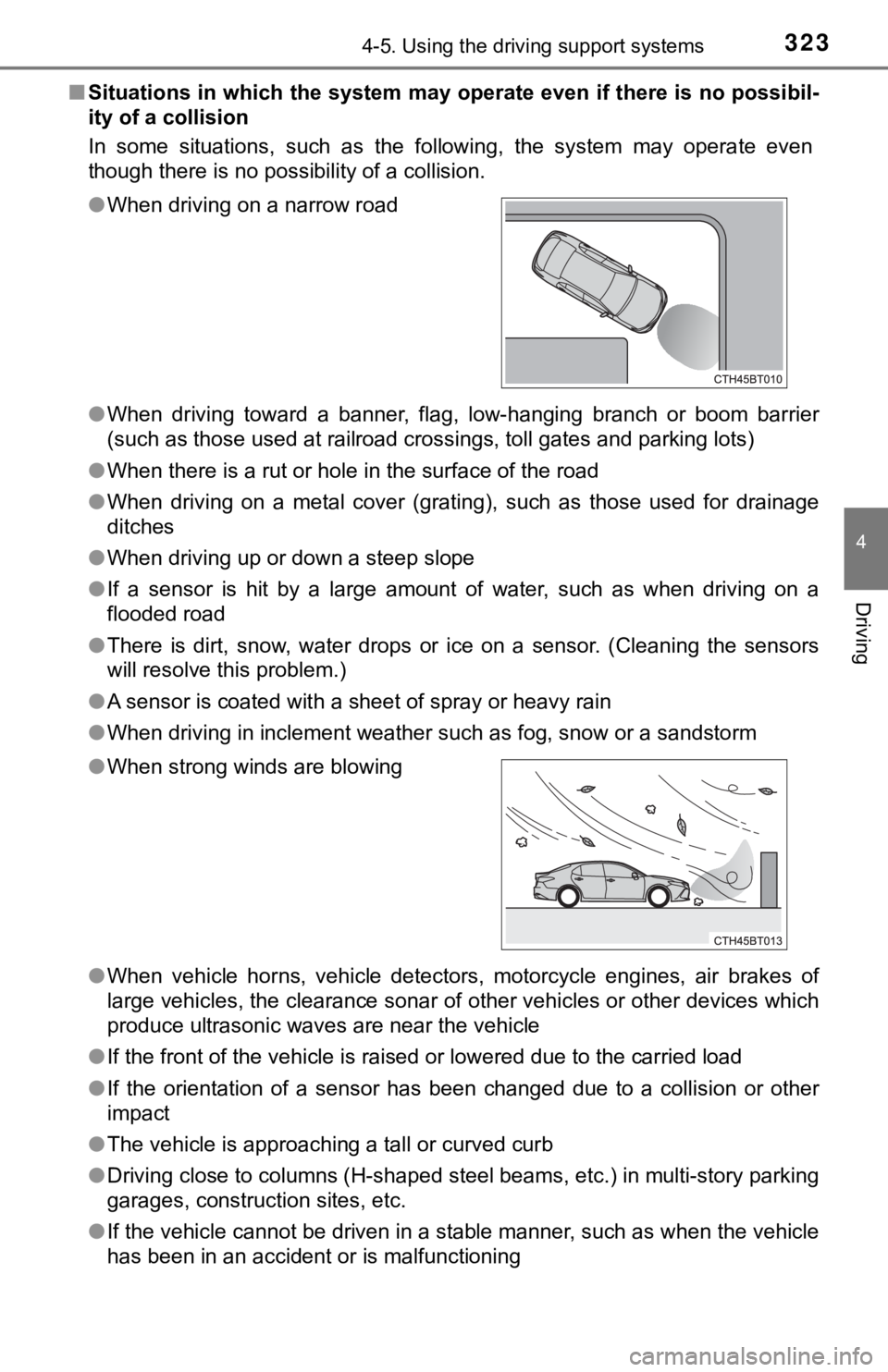
3234-5. Using the driving support systems
4
Driving
■Situations in which the system may operate even if there is no possibil-
ity of a collision
In some situations, such as the following, the system may operate even
though there is no possibility of a collision.
●When driving toward a banner, flag, low-hanging branch or boom barrier
(such as those used at railroad crossings, toll gates and parking lots)
●When there is a rut or hole in the surface of the road
●When driving on a metal cover (grating), such as those used for drainage
ditches
●When driving up or down a steep slope
●If a sensor is hit by a large amount of water, such as when driving on a
flooded road
●There is dirt, snow, water drops or ice on a sensor. (Cleaning the sensors
will resolve this problem.)
●A sensor is coated with a sheet of spray or heavy rain
●When driving in inclement weather such as fog, snow or a sandstorm
●When vehicle horns, vehicle detectors, motorcycle engines, air brakes of
large vehicles, the clearance sonar of other vehicles or other devices which
produce ultrasonic waves are near the vehicle
●If the front of the vehicle is raised or lowered due to the carried load
●If the orientation of a sensor has been changed due to a collision or other
impact
●The vehicle is approaching a tall or curved curb
●Driving close to columns (H-shaped steel beams, etc.) in multi-story parking
garages, construction sites, etc.
●If the vehicle cannot be driven in a stable manner, such as when the vehicle
has been in an accident or is malfunctioning ●When driving on a narrow road
●When strong winds are blowing
Page 325 of 624

3254-5. Using the driving support systems
4
Driving
WARNING
■Notes when washing the vehicle
Do not apply intensive bursts of water or steam to the sensor area.
Doing so may result in the sensor malfunctioning.
●When using a high pressure washer to wash the vehicle, do not spray the
sensors directly, as doing so may cause a sensor to malfunction.
●When using steam to clean the vehicle, do not direct steam too close to
<0057004b004800030056004800510056005200550056000300440056000300470052004c0051004a000300560052000300500044005c000300460044005800560048000300440003005600480051005600520055000300570052000300500044004f004900
58005100460057004c005200510011[
●When using an automatic car wash, disable the intuitive parking assist.
Page 328 of 624
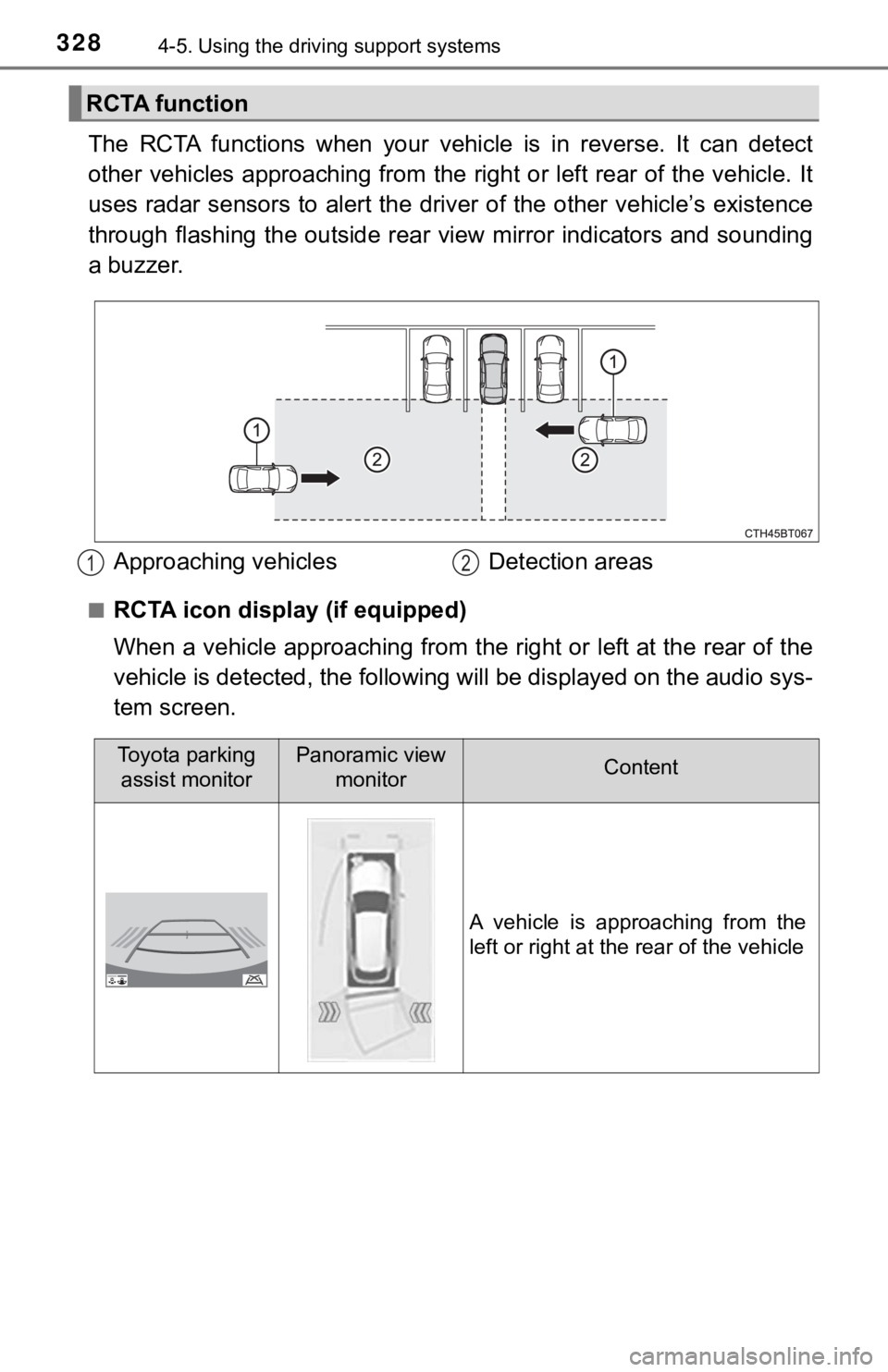
3284-5. Using the driving support systems
The RCTA functions when your vehicle is in reverse. It can detect
other vehicles approaching from the right or left rear of the vehicle. It
uses radar sensors to alert the driver of the other vehicle’s existence
through flashing the outside rear view mirror indicators and sounding
a buzzer.
■RCTA icon display (if equipped)
When a vehicle approaching from the right or left at the rear of the
vehicle is detected, the following will be displayed on the audio sys-
tem screen.
RCTA function
Approaching vehicles Detection areas12
Toyota parking
assist monitorPanoramic view
monitorContent
A vehicle is approaching from the
left or right at the rear of the vehicle
Page 331 of 624
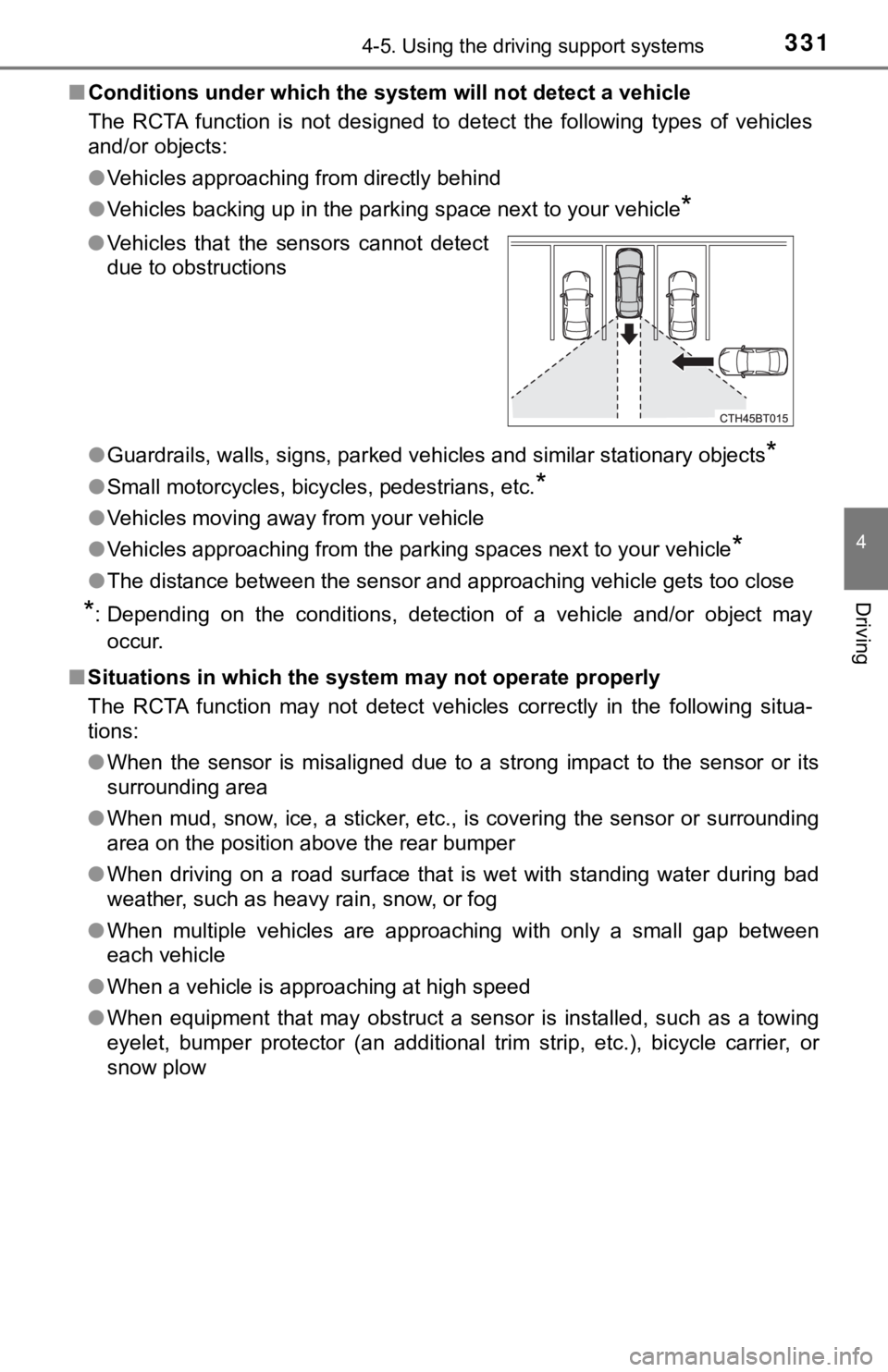
3314-5. Using the driving support systems
4
Driving
■Conditions under which the system will not detect a vehicle
The RCTA function is not designed to detect the following types of vehicles
and/or objects:
●Vehicles approaching from directly behind
●Vehicles backing up in the parking space next to your vehicle
*
●<002a005800440055004700550044004c004f0056000f0003005a0044004f004f0056000f00030056004c004a00510056000f0003005300440055004e00480047000300590048004b004c0046004f00480056000300440051004700030056004c0050004c00
4f0044005500030056005700440057004c0052005100440055[y objects*
●Small motorcycles, bicycles, pedestrians, etc.*
●Vehicles moving away from your vehicle
●Vehicles approaching from the parking spaces next to your vehicle
*
●The distance between the sensor and approaching vehicle gets too close
*: Depending on the conditions, detection of a vehicle and/or object may
occur.
■Situations in which the system may not operate properly
The RCTA function may not detect vehicles correctly in the following situa-
tions:
●When the sensor is misaligned due to a strong impact to the sensor or its
surrounding area
●When mud, snow, ice, a sticker, etc., is covering the sensor or surrounding
area on the position above the rear bumper
●When driving on a road surface that is wet with standing water during bad
weather, such as heavy rain, snow, or fog
●When multiple vehicles are approaching with only a small gap between
each vehicle
●When a vehicle is approaching at high speed
●When equipment that may obstruct a sensor is installed, such as a towing
eyelet, bumper protector (an additional trim strip, etc.), bicycle carrier, or
snow plow ●Vehicles that the sensors cannot detect
due to obstructions
Page 340 of 624

3404-5. Using the driving support systems
■Parking Support Brake function (static objects)
Ultrasonic sensors are used to detect static objects, such as a wall,
in the detection area when driving at a low speed or backing up.
(P. 348)
■Parking Support Brake function (rear-crossing vehicles)
Rear radar sensors are used to detect approaching vehicles in the
detection area behind the vehicle when backing up. (P. 352)
PKSB (Parking Suppor t Brake)
: If equipped
The Parking Support Brake system consists of the following
functions that operate when driving at a low speed or backing
up, such as when parking. When the system determines that the
possibility of a collision with a detected object is high, a warning
operates to urge the driver to take evasive action. If the system
determines that the possibility of a collision with a detected
object is extremely high, the brakes are automatically applied to
help avoid the collision or help reduce the impact of the colli-
sion.
PKSB (Parking Support Brake) system
Page 341 of 624
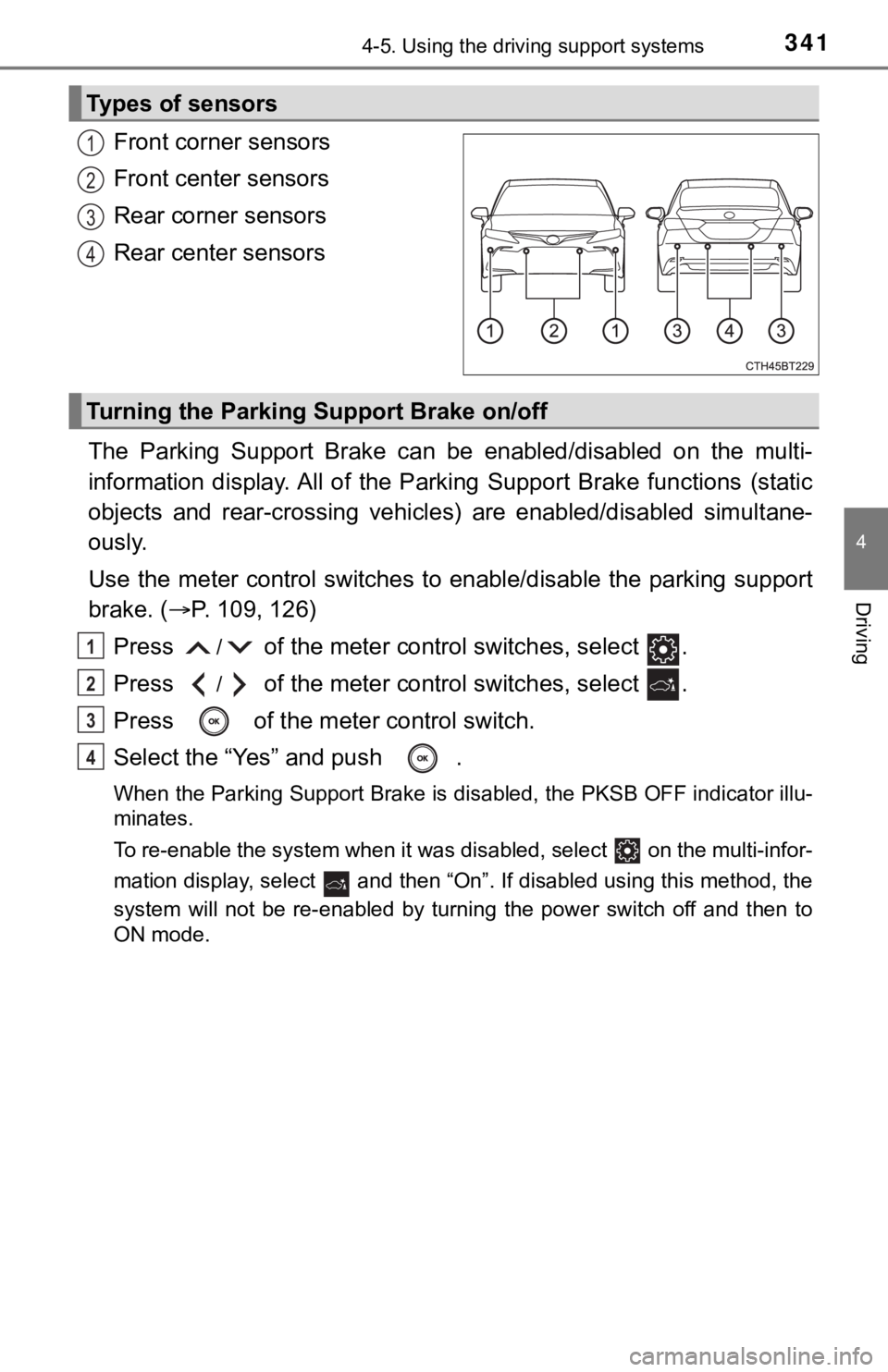
3414-5. Using the driving support systems
4
Driving
Front corner sensors
Front center sensors
Rear corner sensors
Rear center sensors
The Parking Support Brake can be enabled/disabled on the multi-
information display. All of the Parking Support Brake functions (static
objects and rear-crossing vehicles) are enabled/disabled simultane-
ously.
Use the meter control switches to enable/disable the parking support
brake. (P. 109, 126)
Press
/ of the meter control switches, select .
Press
/ of the meter control switches, select .
Press of the meter control switch.
Select the “Yes” and push .
When the Parking Support Brake is disabled, the PKSB OFF indicator illu-
minates.
To re-enable the system when it was disabled, select on the multi-infor-
mation display, select and then “On”. If disabled using this method, the
system will not be re-enabled by turning the power switch off and then to
ON mode.
Types of sensors
1
2
3
4
Turning the Parking Support Brake on/off
1
2
3
4
Page 346 of 624
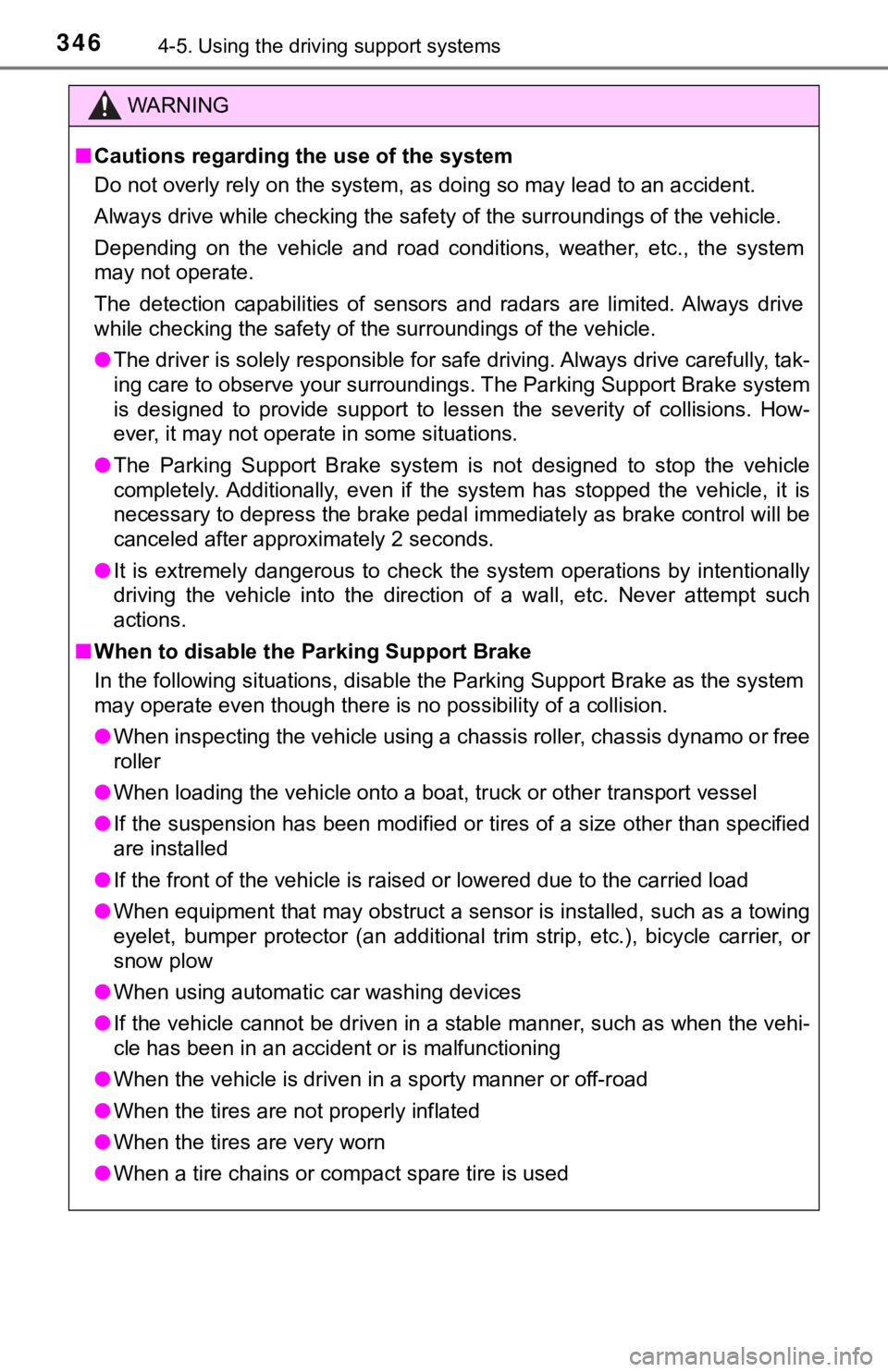
3464-5. Using the driving support systems
WARNING
■Cautions regarding the use of the system
Do not overly rely on the system, as doing so may lead to an accident.
Always drive while checking the safety of the surroundings of the vehicle.
Depending on the vehicle and road conditions, weather, etc., the system
may not operate.
The detection capabilities of sensors and radars are limited. Always drive
<005a004b004c004f004800030046004b00480046004e004c0051004a00030057004b0048000300560044004900480057005c00030052004900030057004b0048000300560058005500550052005800510047004c0051004a00560003005200490003005700
4b0048000300590048004b004c0046004f00480011[
●The driver is solely responsible for safe driving. Always drive carefully, tak-
ing care to observe your surroundings. The Parking Support Brake system
is designed to provide support to lessen the severity of collisions. How-
ever, it may not operate in some situations.
●The Parking Support Brake system is not designed to stop the vehicle
completely. Additionally, even if the system has stopped the vehicle, it is
<00510048004600480056005600440055005c0003005700520003004700480053005500480056005600030057004b00480003004500550044004e004800030053004800470044004f0003004c0050005000480047004c004400570048004f005c0003004400
560003004500550044004e0048000300460052005100570055[ol will be
canceled after approximately 2 seconds.
●It is extremely dangerous to check the system operations by intentionally
driving the vehicle into the direction of a wall, etc. Never attempt such
actions.
■When to disable the Parking Support Brake
In the following situations, disable the Parking Support Brake as the system
may operate even though there is no possibility of a collision.
●When inspecting the vehicle using a chassis roller, chassis dynamo or free
roller
●When loading the vehicle onto a boat, truck or other transport vessel
●If the suspension has been modified or tires of a size other than specified
are installed
●If the front of the vehicle is raised or lowered due to the carried load
●When equipment that may obstruct a sensor is installed, such as a towing
eyelet, bumper protector (an additional trim strip, etc.), bicycle carrier, or
snow plow
●When using automatic car washing devices
●If the vehicle cannot be driven in a stable manner, such as when the vehi-
cle has been in an accident or is malfunctioning
●When the vehicle is driven in a sporty manner or off-road
●When the tires are not properly inflated
●When the tires are very worn
●When a tire chains or compact spare tire is used
Page 348 of 624
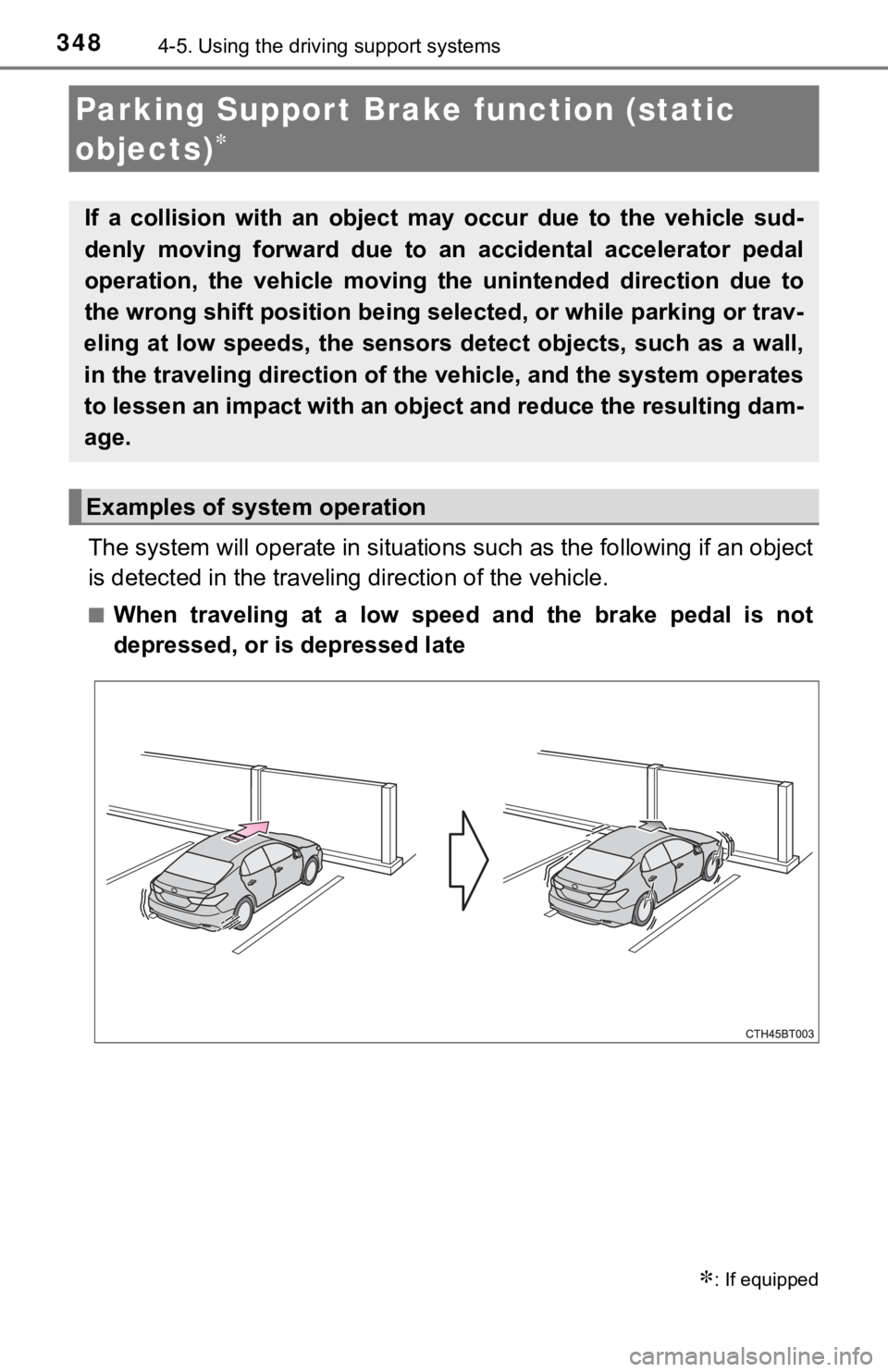
3484-5. Using the driving support systems
The system will operate in situations such as the following if an object
is detected in the traveling direction of the vehicle.
■When traveling at a low speed and the brake pedal is not
depressed, or is depressed late
Parking Suppor t Brake function (static
objects)
: If equipped
If a collision with an object may occur due to the vehicle sud-
denly moving forward due to an accidental accelerator pedal
operation, the vehicle moving the unintended direction due to
the wrong shift position being selected, or while parking or trav-
eling at low speeds, the sensors detect objects, such as a wall,
in the traveling direction of the vehicle, and the system operates
to lessen an impact with an object and reduce the resulting dam-
age.
Examples of system operation